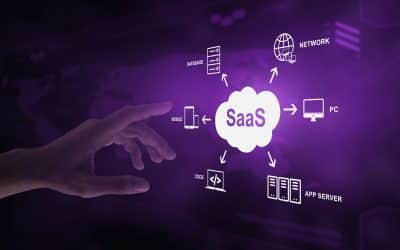As SaaS software development companies focus on making secure SaaS applications that meet growing user bases is paramount for business success. Businesses relying heavily on cloud solutions require agile, resilient software with good security measures as they rely on these cloud offerings more and more. It, therefore, becomes imperative for developers to have an in-depth knowledge of best practices that guarantee scalability as user bases expand while protecting sensitive information in an age of increasing cyber threats.
The next sections explore the foundational principles, architectural considerations, and strategic approaches required of developers, architects, and decision-makers to develop SaaS applications that meet market demand and comply with rigorous security standards. From encryption protocols to microservice architecture design considerations – this guide offers actionable insights for steering SaaS development toward greater scalability, efficiency, and robust security.
Foundational Principles of Secure SaaS Architecture
The foundational principles of secure Software as a Service (SaaS) architecture form the bedrock upon which resilient and trustworthy applications are built. At the core of these principles lies a commitment to data security, user privacy, and system integrity. Encryption serves as a linchpin in this framework, ensuring that sensitive information remains confidential during transmission and storage. Employing robust authentication and authorization mechanisms is equally crucial, allowing for granular control over user access and permissions within the SaaS ecosystem. A well-defined access control strategy, such as Role-Based Access Control (RBAC), enhances security by restricting user privileges based on predefined roles.
In parallel, the adoption of secure coding practices is imperative. This involves vigilant input validation, secure session management, and adherence to coding standards that mitigate common vulnerabilities such as injection attacks and cross-site scripting. Beyond the application layer, secure SaaS architecture extends to the infrastructure level, encompassing measures like regular security audits, patch management, and secure configuration of servers and databases. The incorporation of threat modeling at the design phase aids in anticipating and mitigating potential security risks.
Furthermore, the principle of resilience guides the architecture’s ability to withstand and recover from unexpected events, whether they be hardware failures or cyber-attacks. The establishment of comprehensive logging and monitoring mechanisms allows for real-time visibility into system activities, facilitating the timely detection and response to security incidents. Ultimately, the foundational principles of secure SaaS architecture create a holistic environment where scalability is harmoniously balanced with uncompromising security, laying the groundwork for robust, dependable, and trustworthy SaaS applications.
Scalability Planning and Forecasting in SaaS
Scalability planning and forecasting play pivotal roles in the development and sustained success of Software as a Service (SaaS) applications. As the user base and data loads fluctuate, a well-designed scalability strategy ensures that the SaaS infrastructure can adapt seamlessly to varying demands. An essential aspect of this planning involves the identification of potential bottlenecks within the system, whether they lie in the application code, databases, or network architecture. Through thorough performance testing and analysis, developers can gauge the application’s capacity limits and proactively address scalability challenges.
Forecasting, on the other hand, requires a meticulous examination of historical usage patterns and an anticipation of future growth. Accurate predictions facilitate resource allocation, allowing SaaS providers to scale their infrastructure in a cost-effective and timely manner. Cloud services, with their elastic nature, provide an ideal environment for scalability, allowing organizations to dynamically adjust resources based on demand. Collaborating with cloud service providers to implement auto-scaling features ensures that the SaaS application automatically adjusts its capacity in response to varying workloads.
Furthermore, scalability planning encompasses considerations of both horizontal and vertical scaling. Horizontal scaling involves adding more instances of resources, such as servers, to distribute the load, while vertical scaling involves increasing the power of existing resources. Striking the right balance between these approaches is essential to optimize performance and cost-effectiveness. In essence, scalability planning and forecasting empower SaaS developers to build systems that not only meet current demands but are also agile and prepared for future growth, providing users with a consistently high-quality experience.
Encryption Protocols for Data Security in SaaS
Encryption protocols serve as the cornerstone for ensuring robust data security in Software as a Service (SaaS) applications, safeguarding sensitive information from unauthorized access and potential breaches. As data traverses networks and resides in storage, employing industry-standard encryption algorithms is crucial to protect its confidentiality and integrity. The use of secure communication protocols, such as Transport Layer Security (TLS) or its predecessor, Secure Sockets Layer (SSL), encrypts data in transit, preventing eavesdropping and man-in-the-middle attacks.
At rest, data encryption ensures that information stored in databases or other repositories remains indecipherable to unauthorized entities. Advanced Encryption Standard (AES) is commonly employed for encrypting data at rest, providing a robust and widely accepted cryptographic solution. Additionally, adopting a comprehensive key management strategy is essential to safeguard the encryption keys themselves, preventing unauthorized access to the very means of decrypting sensitive data.
In a multi-tenant SaaS environment, where multiple users share the same infrastructure, implementing end-to-end encryption becomes imperative. This approach ensures that even service providers cannot access the plaintext data, enhancing the overall security posture of the SaaS application. Striking a balance between encryption strength and performance is crucial, and developers must consider the computational overhead of encryption and decryption processes.
Moreover, as security threats evolve, staying abreast of the latest encryption standards and periodically updating protocols is essential. Encryption protocols, when thoughtfully integrated into the fabric of SaaS application development, provide a robust defense against data breaches, instilling confidence among users and meeting stringent regulatory requirements for data protection and privacy.
Role-Based Access Control (RBAC) Implementation
The implementation of Role-Based Access Control (RBAC) stands as a fundamental and effective strategy in ensuring secure and structured access within Software as a Service (SaaS) applications. RBAC is a model that streamlines permissions based on predefined roles, allowing administrators to allocate specific privileges to users based on their responsibilities and functions within the system. This approach enhances security by minimizing the risk of unauthorized access and potential misuse of sensitive data.
In RBAC, each user is assigned a specific role that corresponds to their role or job function within the organization. Roles are associated with a set of permissions that dictate what actions or data a user with that role can access. This granular control not only simplifies the management of user access but also significantly reduces the surface area for potential security vulnerabilities.
RBAC implementation involves the creation and management of roles, mapping them to relevant permissions, and associating users with specific roles. This structured approach ensures that users have the minimum necessary access rights to perform their tasks, following the principle of least privilege. Moreover, RBAC facilitates efficient onboarding and offboarding processes, as access privileges are tied to roles rather than individual users.
The adoption of RBAC in SaaS applications promotes not only security but also scalability. As organizations evolve and user roles change, RBAC provides a flexible framework to adapt access controls accordingly. By fostering a systematic and manageable access control system, RBAC serves as a linchpin in establishing a robust security architecture for SaaS platforms, contributing to the overall integrity and trustworthiness of the application.
Efficient Handling of Large Datasets in SaaS
Efficient handling of large datasets is a critical consideration in the development of Software as a Service (SaaS) applications, as the seamless processing of substantial volumes of data is paramount for performance, scalability, and user experience. SaaS platforms often deal with diverse datasets ranging from user-generated content to analytical data, and devising strategies to manage, store, and retrieve this information is crucial.
Optimizing database design is a key facet of addressing the challenges posed by large datasets. Utilizing appropriate database engines and indexing methodologies ensures quick and efficient data retrieval, reducing latency and enhancing overall application responsiveness. Employing sharding techniques, where large datasets are horizontally partitioned across multiple database instances, distributes the load and enables parallel processing, thereby improving scalability.
Caching mechanisms also play a pivotal role in enhancing the efficiency of data handling in SaaS software solutions. By storing frequently accessed or computationally expensive data in a cache, such as in-memory databases or distributed caching systems, applications can reduce the need for repeated, resource-intensive queries to the primary data store.
Moreover, employing scalable storage solutions, such as cloud-based object storage services, facilitates the cost-effective storage of large datasets while providing the flexibility to scale resources based on demand. Implementing data compression techniques and optimizing data transfer protocols further contribute to efficient data handling, especially in scenarios where bandwidth and network latency are concerns.
In conclusion, addressing the challenges associated with large datasets in SaaS requires a multifaceted approach encompassing database optimization, sharding, caching strategies, and scalable storage solutions. By adopting these efficient handling practices, SaaS developers can ensure that their applications deliver optimal performance, scalability, and responsiveness in the face of increasing data volumes.
API Security: Authentication and Authorization
API security, with a specific focus on authentication and authorization, is a cornerstone of ensuring the integrity and protection of Software as a Service (SaaS) applications. Authentication verifies the identity of users or systems attempting to access the API, preventing unauthorized entry. Utilizing robust authentication mechanisms, such as OAuth 2.0 or API keys, is essential to validate the legitimacy of incoming requests. OAuth 2.0, for instance, facilitates secure, token-based authentication, enabling users to grant specific permissions to applications without exposing their credentials.
Authorization, the subsequent layer of API security, governs the permissions and actions granted to authenticated entities. Role-Based Access Control (RBAC) is often employed to enforce fine-grained control, allowing organizations to define and manage user roles and associated permissions within the API ecosystem. Ensuring that users only have access to the resources and actions they require is vital in mitigating the risk of unauthorized data access or manipulation.
Furthermore, the adoption of industry-standard security protocols, such as HTTPS, adds an extra layer of encryption to API communication, safeguarding sensitive data during transit. Regularly updating and patching security vulnerabilities in both the API codebase and underlying infrastructure is imperative to stay ahead of evolving threats.
API security extends beyond initial implementation, requiring ongoing monitoring and auditing. Implementing robust logging mechanisms allows for the detection of suspicious activities, aiding in the identification of potential security breaches. By prioritizing authentication and authorization measures in API design and maintenance, SaaS developers fortify their applications against unauthorized access, data breaches, and other security threats, ensuring the trust and confidence of users.
Automated Testing for Secure SaaS Code
Automated testing is a pivotal component in ensuring the security and reliability of Software as a Service (SaaS) code, providing an efficient means to detect and address vulnerabilities throughout the development lifecycle. Security vulnerabilities, if left undetected, can lead to serious consequences such as data breaches or service disruptions. Automated testing helps mitigate these risks by systematically assessing the application’s codebase for common security issues.
In the context of secure SaaS code development, automated testing spans various categories, including static analysis, dynamic analysis, and interactive application security testing (IAST). Static analysis tools examine the source code without executing it, identifying potential vulnerabilities and security flaws early in the development process. Dynamic analysis involves evaluating the application in a runtime environment to detect vulnerabilities that may arise during execution. IAST combines elements of both static and dynamic analysis, offering a comprehensive assessment of security issues within the application.
Integrating security-focused testing into the continuous integration and continuous deployment (CI/CD) pipeline ensures that security checks are conducted consistently and automatically with each code change. This approach helps identify and rectify security issues promptly, minimizing the risk of deploying vulnerable code into production. Additionally, incorporating security testing into the development workflow promotes a proactive security culture, encouraging developers to address vulnerabilities during the coding phase.
Automated testing tools specific to security, such as static analyzers, penetration testing tools, and vulnerability scanners, aid developers in identifying issues related to input validation, authentication, authorization, and encryption. Regularly updating these testing tools to stay abreast of emerging threats is crucial for maintaining the effectiveness of security testing practices. Ultimately, automated testing for secure SaaS code not only enhances the robustness of the application but also contributes to the establishment of a resilient and trustworthy software development lifecycle.
Compliance Frameworks in SaaS Development
Compliance frameworks play a central role in the development of Software as a Service (SaaS) applications, guiding organizations to adhere to regulatory standards and industry-specific requirements. These frameworks provide a structured approach to ensure that SaaS platforms operate within legal and ethical boundaries while safeguarding user data and maintaining a secure environment.
Common compliance frameworks include standards like General Data Protection Regulation (GDPR), Health Insurance Portability and Accountability Act (HIPAA), Payment Card Industry Data Security Standard (PCI DSS), and others, each tailored to address specific sectors and concerns. Implementing a compliance framework begins with a comprehensive assessment of the application’s data handling practices, security protocols, and overall risk management.
For instance, GDPR, which focuses on data protection and privacy for European Union citizens, necessitates robust consent mechanisms, data encryption, and the appointment of a Data Protection Officer. HIPAA, designed for healthcare applications, mandates stringent controls on the storage and transmission of patient information. PCI DSS is vital for SaaS applications processing payment card data, outlining security measures to protect against credit card fraud.
Incorporating compliance into the SaaS development lifecycle involves continuous monitoring, periodic audits, and documentation to demonstrate adherence to the specified standards. Deviations from compliance are promptly addressed, and corrective measures are implemented to ensure ongoing alignment with regulatory requirements.
Adherence to compliance frameworks not only safeguards the application from legal repercussions but also fosters trust among users by assuring them of stringent data protection and security measures. By proactively integrating compliance considerations into SaaS development, organizations can navigate regulatory landscapes effectively, instilling confidence in users and stakeholders while establishing a robust foundation for responsible and ethical software deployment.
User Authentication Best Practices in SaaS
User authentication is a critical aspect of Software as a Service (SaaS) development, serving as the first line of defense against unauthorized access and ensuring the confidentiality of sensitive user data. Adopting best practices in user authentication is essential for creating a secure and trustworthy SaaS environment.
Multi-factor authentication (MFA) stands out as a foundational best practice, requiring users to provide multiple forms of identification before gaining access. This typically involves a combination of passwords, one-time codes, biometrics, or smart cards, adding an extra layer of security beyond traditional username and password combinations.
Password policies play a crucial role in bolstering user authentication. Encouraging the use of strong, unique passwords and enforcing regular password updates helps mitigate the risk of unauthorized access due to compromised credentials. Hashing and salting passwords before storage further enhance security by making it computationally challenging for attackers to decipher passwords even if they gain access to the stored data.
Secure communication protocols, such as HTTPS, are integral in safeguarding user credentials during the authentication process. Encrypting data in transit prevents eavesdropping and man-in-the-middle attacks, ensuring the confidentiality and integrity of user authentication information.
Continuous monitoring and adaptive authentication mechanisms contribute to a dynamic and responsive security posture. Anomaly detection algorithms can identify unusual user behavior, triggering additional authentication steps when deviations from normal patterns are detected.
User education is equally vital. Providing clear guidelines on secure password practices, the importance of MFA, and recognizing phishing attempts helps users become active participants in maintaining the security of their accounts.
In conclusion, user authentication best practices in SaaS involve a multifaceted approach encompassing MFA, robust password policies, secure communication protocols, continuous monitoring, and user education. Implementing these practices not only protects user accounts but also fortifies the overall security posture of SaaS applications, instilling confidence in users and meeting stringent data protection standards.
End-to-End Encryption for Sensitive Information
End-to-End Encryption (E2EE) stands as a paramount strategy in Software as a Service (SaaS) development, especially when dealing with sensitive information. This cryptographic technique ensures that data is securely transmitted and stored in a manner that only authorized parties—usually the sender and the intended recipient—can decipher it. In the context of SaaS applications, where user data privacy is of utmost importance, implementing E2EE mitigates the risk of unauthorized access, even if the data is intercepted during transmission or resides on servers controlled by the service provider.
E2EE functions by encrypting the data at its source and maintaining that encryption throughout its journey, only decrypting it at the destination. This ensures that, even if communication channels or data repositories are compromised, the intercepted information remains indecipherable without the corresponding encryption keys. Sensitive data, such as personal identifiable information (PII), financial details, or proprietary business data, benefits significantly from this robust level of protection.
Implementing E2EE requires careful consideration of key management, as secure distribution and storage of encryption keys are critical to maintaining the integrity of the encryption process. Additionally, it’s essential to communicate transparently with users about the application’s security measures, fostering trust by assuring them that their sensitive information is shielded from unauthorized access.
While E2EE contributes significantly to data security, developers must also weigh the potential trade-offs in terms of performance and usability. Striking the right balance between security and user experience is crucial for the successful implementation of E2EE in SaaS applications, offering a robust defense against unauthorized access and bolstering user confidence in the protection of their sensitive information.
Containerization for Scalable SaaS Deployments
Containerization has emerged as a cornerstone strategy in Software as a Service (SaaS) development, particularly for achieving scalable and efficient deployments. Containers encapsulate an application and its dependencies, ensuring consistent performance across different environments. Platforms like Docker and container orchestration tools such as Kubernetes have become instrumental in orchestrating and managing containerized applications, offering numerous benefits for scalable SaaS deployments.
One of the primary advantages of containerization is the abstraction of the application from the underlying infrastructure. This abstraction promotes consistency and eliminates the common challenge of “it works on my machine” by packaging the application with its dependencies into a standardized unit, known as a container. This not only streamlines the development and testing processes but also facilitates seamless deployment across various environments, enhancing scalability.
Containers also enable a microservices architecture, allowing SaaS applications to be broken down into smaller, independently deployable units. This modularity enhances scalability by enabling developers to scale specific components of the application as needed, optimizing resource utilization. Kubernetes, with its robust orchestration capabilities, automates the deployment, scaling, and management of containerized applications, providing a resilient infrastructure for scalable SaaS solutions.
Furthermore, containerization fosters efficient resource utilization, as containers share the host operating system’s kernel, reducing overhead and enabling higher density on the same infrastructure. This resource efficiency is crucial for achieving cost-effective and scalable deployments, especially in cloud environments.
In summary, containerization offers a transformative approach to scalable SaaS deployments by providing consistency, modularity, and efficient resource utilization. When combined with orchestration tools like Kubernetes, it becomes a powerful enabler for building, deploying, and managing scalable SaaS applications in a dynamic and rapidly evolving technological landscape.
Microservices Architecture and Scalability
Microservices architecture has emerged as a pivotal paradigm in Software as a Service (SaaS) development, offering a scalable and modular approach to building complex applications. In a microservices architecture, an application is decomposed into small, independent services, each responsible for a specific business capability. This decomposition allows for improved scalability by enabling independent scaling of individual microservices based on demand.
The modular nature of microservices facilitates horizontal scaling, where additional instances of specific services can be deployed to handle increased workloads. Unlike monolithic architectures, where scaling involves replicating the entire application, microservices allow developers to scale only the components that experience higher demand, optimizing resource utilization and cost-effectiveness.
Moreover, microservices promote flexibility and agility in development and deployment. Each microservice can be developed, deployed, and scaled independently, enabling continuous integration and continuous deployment (CI/CD) practices. This agility is crucial for rapidly evolving SaaS applications, allowing developers to respond to changing requirements and user demands with minimal disruption.
Additionally, microservices support fault isolation, enhancing the overall resilience of the application. If a single microservice experiences a failure, it does not necessarily impact the entire system, as other services can continue to function independently. This fault isolation minimizes downtime and ensures that the overall SaaS application remains available and responsive.
While microservices architecture offers numerous advantages for scalability, it also introduces challenges such as inter-service communication, data consistency, and management complexity. Successful implementation requires careful consideration of these challenges, but when done effectively, microservices provide a scalable foundation for building resilient, adaptable, and high-performance SaaS applications.
Securely Managing SaaS User Sessions
Securely managing Software as a Service (SaaS) user sessions is a critical aspect of ensuring the overall security and integrity of user interactions with the application. User sessions are established when a user logs into the SaaS platform, and effective management of these sessions is paramount for safeguarding user identity, preventing unauthorized access, and protecting sensitive data. To achieve this, robust session management practices must be implemented.
Authentication mechanisms, such as multi-factor authentication (MFA) and secure password policies, play a pivotal role in establishing the initial user session securely. Once authenticated, secure session management involves the use of secure session tokens. These tokens, generated during the authentication process, serve as proof of a user’s authenticated status and are typically stored as cookies or in-memory variables. Ensuring that session tokens are transmitted over secure channels, such as HTTPS, prevents interception and unauthorized access.
Implementing session timeouts and idle session management mechanisms is essential for mitigating the risk of session hijacking. By automatically terminating inactive sessions and requiring reauthentication, the likelihood of an attacker exploiting a dormant session is significantly reduced. Additionally, employing secure session storage mechanisms, such as encrypted cookies or session tokens with limited scope, adds an extra layer of protection against session-based attacks.
Regular session auditing and monitoring help detect and respond to suspicious activities, allowing for timely intervention in the case of unauthorized access or anomalous behavior. Educating users about best practices, including logging out of sessions on shared devices and recognizing signs of potential account compromise, further enhances the overall security posture of SaaS user sessions.
In conclusion, securely managing SaaS user sessions involves a comprehensive approach, encompassing strong authentication, secure session token management, encrypted communication, session timeout strategies, and continuous monitoring. By prioritizing these measures, SaaS providers can fortify the protection of user sessions, maintain the integrity of user interactions, and uphold the trust of their user base.
Securing Communication Channels in SaaS
Securing communication channels in Software as a Service (SaaS) is imperative to protect sensitive data during transmission and mitigate the risk of unauthorized access or eavesdropping. Employing robust encryption protocols is a foundational measure to ensure the confidentiality and integrity of data in transit. The use of Transport Layer Security (TLS) or its predecessor, Secure Sockets Layer (SSL), encrypts communication between the user’s device and the SaaS server, safeguarding against potential threats such as man-in-the-middle attacks.
Furthermore, enforcing the use of HTTPS (HTTP Secure) for web communication is essential. HTTPS encrypts the data exchanged between the user’s browser and the SaaS application, preventing malicious actors from intercepting or tampering with sensitive information. This is particularly crucial for protecting user credentials, payment details, and any other confidential data transmitted over the network.
Securing APIs and other communication interfaces is equally vital. Implementing API security standards, such as OAuth 2.0, and employing proper authentication and authorization mechanisms ensure that data exchanged between different components of the SaaS application remains protected. Regularly updating cryptographic protocols and algorithms is essential to address evolving security threats and vulnerabilities.
In addition to encryption, implementing strong access controls, monitoring network traffic for anomalies, and conducting regular security audits contribute to the overall robustness of communication channel security. Educating users on the importance of secure communication practices, such as avoiding public Wi-Fi for sensitive transactions, further reinforces the security posture of SaaS applications.
In conclusion, securing communication channels in SaaS requires a multifaceted approach, involving encryption, API security, access controls, monitoring, and user education. By prioritizing these measures, SaaS providers can establish a secure communication infrastructure, instilling confidence in users and meeting the stringent data protection standards essential for the trust and reliability of their services.
Scalable and Secure Identity Management
Scalable and secure identity management is a cornerstone in Software as a Service (SaaS) development, ensuring that users are authenticated and authorized reliably while maintaining the integrity and confidentiality of their identity-related information. In a scalable identity management system, the architecture must accommodate the dynamic growth of users and their associated data. Utilizing distributed databases, load balancing, and horizontal scaling techniques allows the system to handle an increasing number of users efficiently.
To establish secure identity management, multifactor authentication (MFA) serves as a robust layer of defense. By requiring users to provide multiple forms of identification, such as passwords, biometrics, or one-time codes, the system becomes more resilient to unauthorized access attempts. Additionally, secure storage and encryption of user credentials are imperative. Hashing and salting techniques protect passwords from unauthorized disclosure, ensuring that even if the stored data is compromised, deciphering passwords becomes computationally challenging.
Implementing industry-standard identity protocols, such as OAuth 2.0 or OpenID Connect, enhances interoperability and security. These protocols facilitate secure authentication and authorization processes, allowing users to access SaaS applications seamlessly while maintaining control over their identity information.
Regular auditing, monitoring, and anomaly detection mechanisms contribute to the overall security of identity management. Unusual patterns or suspicious activities can be promptly identified, allowing for timely responses and mitigating potential security threats.
In conclusion, achieving scalable and secure identity management in SaaS necessitates a combination of architectural considerations, strong authentication methods, encryption practices, and continuous monitoring. By prioritizing these measures, SaaS providers can establish a robust identity management infrastructure, fostering user trust and meeting the stringent security requirements essential for the success of their applications.
Incident Response Planning for SaaS
Incident response planning is a critical component of Software as a Service development, aimed at effectively mitigating and managing security incidents to minimize their impact on the application, user data, and overall business operations. A comprehensive incident response plan for SaaS should encompass various phases, including preparation, detection, containment, eradication, recovery, and lessons learned.
In the preparation phase, organizations must proactively identify potential threats, assess vulnerabilities, and establish a well-defined incident response team with designated roles and responsibilities. This phase also involves developing communication strategies to notify stakeholders, users, and regulatory bodies in the event of a security incident.
Detection mechanisms play a pivotal role in identifying security incidents promptly. Utilizing intrusion detection systems, security information and event management (SIEM) tools, and anomaly detection helps organizations detect and respond to security breaches in real-time. Once an incident is detected, the containment phase involves isolating affected systems to prevent further damage and unauthorized access.
Eradication focuses on removing the root cause of the incident, addressing vulnerabilities, and ensuring that the organization is resilient against similar incidents in the future. The recovery phase involves restoring affected systems, validating their integrity, and implementing any necessary improvements to prevent recurrence.
Post-incident analysis and documentation form the lessons learned phase. Organizations should conduct thorough reviews of the incident response process, identifying areas for improvement and updating the incident response plan accordingly. This iterative process ensures that the incident response plan remains adaptive to evolving threats and challenges.
In conclusion, incident response planning for SaaS is a dynamic and proactive approach to cybersecurity, encompassing preparation, detection, containment, eradication, recovery, and continuous improvement. By fostering a robust incident response culture, SaaS providers can effectively safeguard their applications and user data, minimizing the impact of security incidents and maintaining user trust.
Database Sharding for SaaS Scalability
Database sharding is a fundamental strategy in Software as a Service (SaaS) development, particularly for achieving scalability in handling large volumes of data. Sharding involves horizontally partitioning a database into smaller, more manageable segments or “shards,” distributing the data across multiple servers or nodes. This approach facilitates parallel processing and reduces the load on individual database instances, allowing SaaS applications to efficiently scale as user bases and data loads increase.
By distributing data across multiple shards, database sharding improves overall system performance and response times. Each shard operates independently, enabling concurrent data operations and reducing contention for resources. This approach is especially beneficial for SaaS applications that experience high read and write demands, as it allows for parallel data access and retrieval.
Additionally, database sharding aligns with the principles of a multi-tenant architecture, where different tenants share the same infrastructure but have segregated data. Each shard can represent the data of a specific tenant, ensuring data isolation and security while optimizing resource utilization.
However, effective implementation of database sharding requires careful consideration of factors such as data distribution strategy, shard key selection, and maintenance of data consistency across shards. Load balancing mechanisms become crucial to ensure even distribution of workload, preventing performance bottlenecks.
In conclusion, database sharding is a vital technique for achieving scalability in SaaS applications. By horizontally partitioning data and distributing it across multiple shards, SaaS developers can design systems that efficiently handle growing user bases and data loads, delivering optimal performance and responsiveness to users while maintaining data isolation and security.
API Rate Limiting and Throttling Strategies
API rate limiting and throttling strategies are essential components of Software as a Service (SaaS) development, ensuring the stability, security, and fair usage of APIs. Rate limiting refers to the restriction of the number of requests an API consumer can make within a specified time frame, while throttling involves controlling the rate at which these requests are processed by the API server.
The primary goal of rate limiting is to prevent abuse, protect against potential denial-of-service attacks, and ensure equitable resource distribution among users. By defining limits on the number of requests a user or client can make, developers can prevent scenarios where a single user monopolizes resources, causing service degradation for others. Rate limiting can be implemented based on various criteria, including the number of requests per minute, per hour, or per day, depending on the desired level of control.
Throttling, on the other hand, focuses on controlling the rate at which the API processes requests. It prevents server overload by introducing delays between requests or limiting the number of concurrent requests. Throttling is crucial for maintaining system stability, especially during peak usage periods or when dealing with resource-intensive operations.
Strategies for effective rate limiting and throttling involve clear communication with API consumers through appropriate status codes, such as 429 Too Many Requests, and providing rate limit headers in API responses. Additionally, developers should consider implementing token-based rate limiting, where users are identified and authorized based on tokens associated with their API requests.
In conclusion, API rate limiting and throttling are integral to the responsible and secure management of SaaS APIs. These strategies ensure fair resource utilization, protect against abuse, and maintain the overall stability and reliability of SaaS applications by preventing disruptions caused by excessive or malicious API requests.
Ensuring GDPR Compliance in SaaS Systems
Ensuring General Data Protection Regulation (GDPR) compliance is a paramount consideration in the development and operation of Software as a Service systems. GDPR, a comprehensive data protection framework, imposes strict requirements on the processing and handling of personal data of European Union (EU) citizens. SaaS providers must adopt robust measures to safeguard user privacy, prevent unauthorized access, and adhere to the key principles outlined in GDPR.
One fundamental aspect of GDPR compliance in SaaS involves obtaining clear and explicit user consent for the collection and processing of personal data. SaaS systems should implement user-friendly consent mechanisms, clearly stating the purpose of data processing and offering users granular control over their data preferences.
Anonymizing or pseudonymizing personal data is crucial in minimizing risks and enhancing GDPR compliance. By applying these techniques, SaaS providers can protect user identities while retaining the data’s utility for legitimate purposes.
Implementing strong data security measures, including encryption during data transmission and storage, is imperative. SaaS systems must prioritize secure practices to prevent data breaches and maintain the confidentiality and integrity of personal information.
SaaS providers should also facilitate data portability, allowing users to access and transfer their personal data easily. Additionally, robust access controls, like Role-Based Access Control (RBAC), should be in place to restrict unauthorized access to sensitive information.
Regular audits, assessments, and documentation of data processing activities ensure ongoing GDPR compliance. Appointing a Data Protection Officer (DPO) and establishing clear procedures for handling data breaches further demonstrate a commitment to GDPR principles. Ultimately, by integrating these measures into their operations, SaaS providers can navigate the intricate landscape of GDPR compliance, build user trust, and align with the regulatory standards crucial for the protection of personal data.
Adopting Zero Trust Security in SaaS Environments
Adopting Zero Trust Security in Software as a Service (SaaS) environments is a strategic paradigm shift that acknowledges the need to reevaluate traditional security models. The Zero Trust Security model operates on the principle of maintaining scepticism towards any user or system, regardless of their location, until their identity and authorization are explicitly verified. In a SaaS context, this means assuming that users and devices inside the network are just as untrusted as those outside, demanding continuous authentication and validation.
Zero Trust Security emphasizes the importance of identity verification through multifactor authentication (MFA) and device health checks before granting access to SaaS resources. This approach mitigates the risk of unauthorized access, even in scenarios where users connect from various devices or locations.
Micro-segmentation is another key component of Zero Trust Security, aiming to compartmentalize and restrict lateral movement within the SaaS environment. By segmenting the network into smaller, isolated zones, unauthorized access to critical resources is substantially limited, reducing the attack surface.
Continuous monitoring and analytics play a crucial role in the Zero Trust model. Real-time assessment of user behavior, device posture, and network activities enables prompt detection of anomalies or potential security threats. Automated responses can be triggered to dynamically adjust access privileges or isolate compromised components.
Zero Trust Security is particularly relevant in SaaS, where the traditional network perimeter is increasingly porous due to remote work and mobile access. Implementing a Zero Trust approach in SaaS environments enhances data security, protects against sophisticated cyber threats, and ensures that trust is never assumed but continually validated throughout the user’s interaction with SaaS resources.
Scalable Caching Strategies for SaaS Applications
Scalable caching strategies are integral to optimizing performance and responsiveness in Software as a Service (SaaS) applications, where efficient data retrieval and delivery are paramount. Caching involves storing frequently accessed data in a readily available location, reducing the need for repeated and resource-intensive database or computation operations. In a SaaS context, adopting scalable caching strategies becomes essential for accommodating growing user bases and varying workloads.
Distributed caching systems are fundamental to scalability, enabling the seamless expansion of caching infrastructure as application demands increase. By distributing cached data across multiple nodes or servers, SaaS applications can handle higher user loads without sacrificing performance. Popular caching solutions such as Redis or Memcached support distributed architectures, providing fast and reliable data access.
Content Delivery Networks (CDNs) represent another scalable caching strategy for SaaS applications, particularly when dealing with static assets like images, stylesheets, and JavaScript files. CDNs cache and distribute these assets across multiple geographically dispersed servers, reducing latency and enhancing the overall user experience, especially for globally distributed user bases.
Implementing time-based caching and eviction policies is crucial for maintaining cache relevance and preventing outdated or stale data from being served to users. This ensures that the cache remains synchronized with the most recent data changes in the underlying systems. Furthermore, leveraging adaptive caching mechanisms that prioritize frequently accessed or critical data enhances the efficiency of caching strategies.
In conclusion, scalable caching strategies are indispensable for SaaS applications aiming to deliver optimal performance and responsiveness. By embracing distributed caching systems, utilizing CDNs, and implementing intelligent caching policies, SaaS developers can create dynamic and scalable applications that meet user expectations even in the face of increasing data loads and user concurrency.
Securing Serverless Components in SaaS
Securing serverless components is a critical consideration in the development of Software as a Service (SaaS) applications, particularly as serverless architecture becomes increasingly prevalent. Serverless computing relies on ephemeral, event-driven functions executed in the cloud, introducing unique security challenges. Implementing robust security measures is essential to ensure the confidentiality, integrity, and availability of serverless components in a SaaS environment.
Authentication and Authorization mechanisms are foundational to securing serverless components. Access controls must be tightly configured, granting only the necessary permissions to functions and ensuring proper authentication protocols, such as API keys or OAuth tokens, are in place. Adopting the principle of least privilege helps minimize the potential impact of security breaches.
Secure communication practices are crucial for protecting data in transit to and from serverless functions. Implementing Transport Layer Security (TLS) or its equivalent ensures that data is encrypted during transmission, preventing eavesdropping and man-in-the-middle attacks. Additionally, validating and sanitizing input data within serverless functions helps prevent injection attacks, a common security concern.
Continuous monitoring and logging of serverless functions provide insights into potential security threats or anomalies. By leveraging cloud-native monitoring solutions, developers can detect and respond to security incidents promptly. Regular security assessments and code reviews contribute to identifying vulnerabilities and addressing them proactively.
Containerization and sandboxing techniques can add an additional layer of security to serverless components, isolating functions from each other and from the underlying infrastructure. Adopting serverless-specific security tools and frameworks further enhances protection against emerging threats specific to serverless architectures.
In conclusion, securing serverless components in SaaS applications requires a holistic approach, encompassing access controls, secure communication, monitoring, code reviews, and specialized security measures. By prioritizing these strategies, SaaS developers can harness the benefits of serverless computing while maintaining a resilient and secure application environment.
The Key Takeaway
In conclusion, the development and maintenance of Software as a Service (SaaS) applications demand a comprehensive and proactive approach to address various challenges and ensure optimal performance, security, and scalability. Embracing best practices such as scalable caching, microservices architecture, and Zero Trust Security, SaaS providers can meet the evolving demands of users and industry standards.
Security and compliance considerations, including GDPR adherence, identity management, and encryption protocols, must be paramount to foster user trust and protect sensitive data. Additionally, incorporating automated testing, incident response planning, and scalable infrastructure components like containers and serverless architectures contributes to a resilient and agile SaaS development lifecycle.
By continually refining strategies, staying abreast of emerging technologies, and prioritizing user-centric solutions, SaaS developers can navigate the intricate landscape of software development, delivering robust and reliable applications in an ever-evolving digital landscape.











